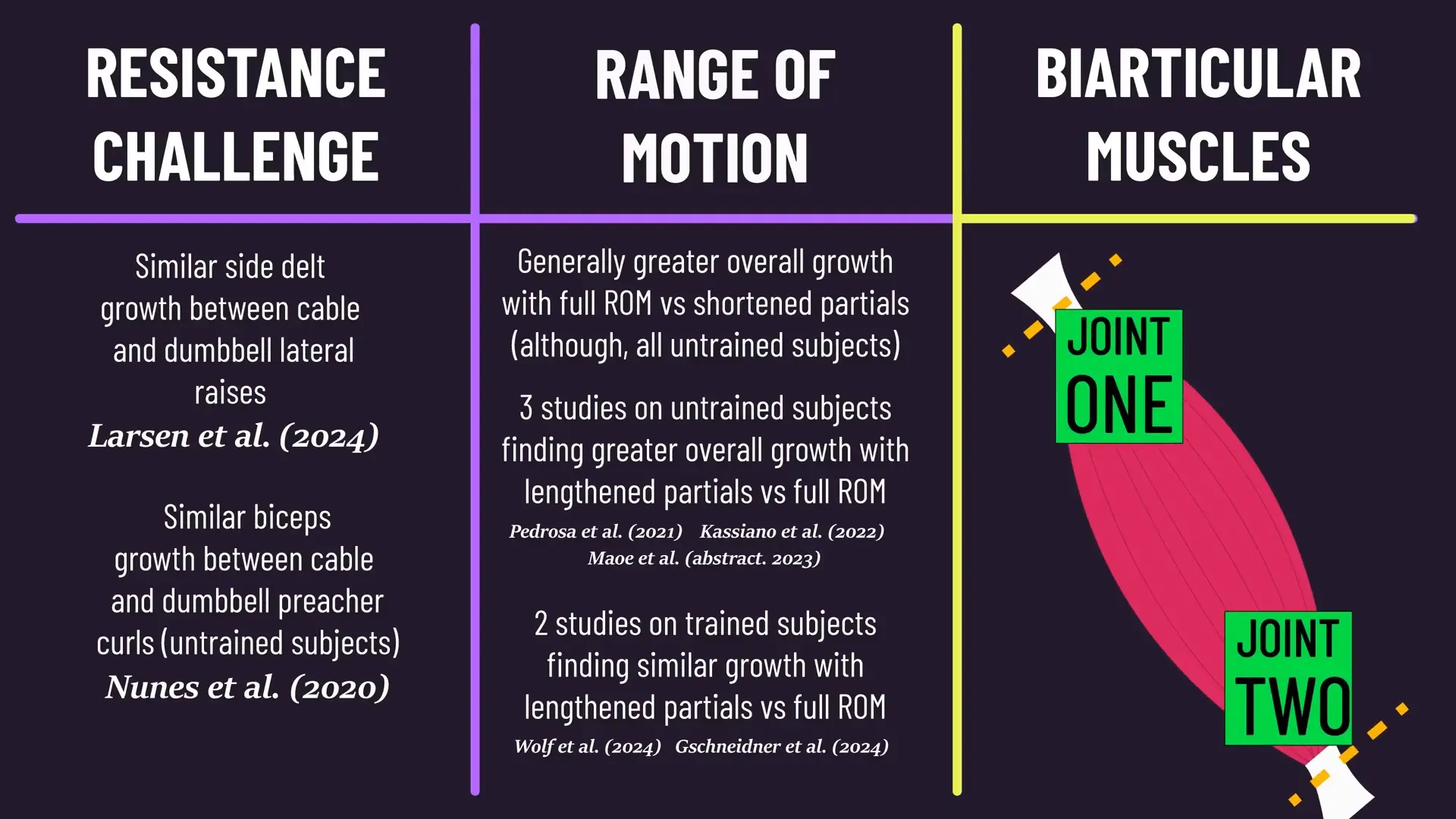Dumbbell vs Cable Raises for Delt Muscle Growth: Which Exercise Is Best?
Boost your side delt growth by adjusting cable and dumbbell lateral raise techniques

Key Takeaways
- You don’t have to choose—both dumbbells and cables work. The study found no major difference in side delt growth.
- Your side delts love tension. Cables keep constant resistance, while dumbbells challenge you more at the top—use both.
- You should train smart. Hitting side delts 2-3x per week ensures solid progress without overtraining.
- Your range of motion can boost results. Cables allow for longer muscle lengths, which may enhance hypertrophy.
- You should switch things up. Avoid adaptation by alternating dumbbells, cables, rep ranges, and intensity techniques.
Want to train smarter and build bigger shoulders?
In this expert review, we analyze, critique, and expand on House of Hypertrophy's look at dumbbell vs cable lateral raises. Our goal is to help you make better exercise choices based on real-world experience and expert insights.
What sets this guide apart?
- Carefully reviewed and fact-checked by experts with 20+ years of gym experience
- Packed with little-known tips to increase delt activation and avoid common mistakes
- Features a science-backed workout based on key insights from the article
If you want to train with precision and build your physique faster, keep reading. We’ll show you exactly how to use dumbbells and cables for maximum shoulder growth.
Related:
- Maximize Shoulder Gains with Cable Lateral Raises
- Mastering the Cable Lateral Raises Technique
- 11 Little-Known Muscle Growth Exercises You Should Try
In a Nutshell: Your Side Delts, Your Rules
Your exercise choice affects resistance. Dumbbells hit hardest at the top, while cables provide constant tension. Want more activation? Try cable lateral raises with a longer range of motion to challenge your side delts in new ways.
You should mix things up! Sticking to one exercise can lead to plateaus, so alternate between dumbbells, cables, rep ranges, and angles. The best plan? Keep experimenting, stay consistent, and enjoy the gains!
| Key Concept | Main Insight |
|---|---|
| Cable vs dumbbell lateral raise | Both build side delts—study found no major difference. |
| Resistance differences | Dumbbells are hardest at the top, cables keep tension. |
| Training frequency | 2-3 sessions per week maximize side delt growth. |
| Range of motion | Cables allow extended movement, possibly boosting gains. |
| Mixing it up | Switching exercises prevents plateaus, keeps progress. |
| Study limitations | Small sample, short duration—more research needed. |
Scientific Side Delt Training

The side deltoids play a vital role in shoulder aesthetics and function. They give your shoulders width, contributing to that coveted V-taper look. Strong side delts are essential for various overhead movements and can enhance your performance in other lifts.
Neglecting side delt training can lead to imbalances. This may cause injuries or hinder your overall strength. Therefore, incorporating effective exercises for side delts should be a priority in your training routine.
Overview of the New Study
A recent study investigated the effects of dumbbell versus cable lateral raises on side delt hypertrophy. It involved twenty-four trained individuals with an average of 7.1 years of experience. Each participant trained both exercises, which allows for a more reliable comparison.
This study is significant as it provides insights into the effectiveness of these common exercises. Understanding how they impact muscle growth can help you make informed decisions about your training.
Comparing Dumbbell and Cable Lateral Raises
Both dumbbells and cables have their unique advantages. Dumbbell lateral raises are often favored for their simplicity and accessibility. They allow for a natural range of motion and can be performed anywhere.
Cable lateral raises, on the other hand, provide constant tension throughout the movement. This can be beneficial for muscle activation, especially at longer muscle lengths. The study aimed to determine if one method yielded superior hypertrophy over the other.
The Study’s Methodology
Participants in the study trained two times a week for eight weeks. They performed five sets per session, pushing to momentary muscular failure within a twelve to sixteen rep range. This method ensured that all subjects experienced similar training stimuli.
To minimize grip fatigue, participants used cuffs, allowing them to focus solely on their side delts. The exercises were performed with the arms moving from zero to ninety degrees in the frontal plane. This setup ensured that both exercises were comparable in range of motion.
Results: Side Delt Growth Observations
The results indicated that both dumbbell and cable lateral raises produced similar growth in side delt thickness. Measurements were taken at both proximal and distal regions of the muscle. This suggests that either exercise can effectively build side deltoid muscle mass.
However, it’s important to note that the amount of hypertrophy observed was relatively small. This is likely due to the already trained status of the participants and the study's short duration. Further research may be necessary to explore potential differences in long-term training adaptations.
Limitations of a Single Study
Every study has its limits. A single study can’t provide definitive answers. It’s like flipping a coin; you might get heads five times in a row. But that doesn’t mean the coin is biased. The same goes for research findings.
In this case, while the study provides valuable insights, it’s essential to approach the results with caution. The findings may not reflect the performance of all individuals or conditions. More studies are needed to solidify these conclusions.
Additionally, the small sample size of twenty-four individuals may not capture the full range of responses to training. Individual differences in genetics, nutrition, and training backgrounds can influence results.
Advanced Considerations for Side Delt Training

Understanding Resistance Challenge
Resistance challenge refers to how difficult an exercise is at different muscle lengths. The study compared how dumbbell and cable lateral raises challenge the side delts. Each exercise has its unique resistance profile.
Dumbbell lateral raises are hardest when the arms are fully extended. In contrast, cable lateral raises provide more tension when the arm is at a longer length. This difference can impact muscle activation and growth.
Understanding these nuances helps you choose the right exercise for your goals. It’s not just about which exercise is better, but about how each can fit into your overall training strategy.
Exploring Range of Motion
Range of motion (ROM) plays a vital role in muscle training. In this study, both exercises had the same range of motion. However, cables allow for unique movements that can further lengthen the muscle. This could potentially lead to greater hypertrophy.
When you bring your arm across your body during cable raises, you engage the side delts in a different way. This extended position may yield different results compared to standard movements.
Research suggests that varying your range of motion can lead to better muscle development. The key is to experiment and find what works best for your body.
The Role of Biarticular Muscles
Biarticular muscles cross two joints and can be affected by joint position. For example, the rectus femoris is a part of the quadriceps that crosses both the knee and hip. Adjusting the position of one joint can enhance muscle length and activation.
This concept applies to various muscle groups, including the calves and biceps. Understanding how to manipulate joint angles can help you target specific muscle fibers more effectively.
Incorporating these principles into your training can lead to better results. It’s about maximizing the potential of each exercise by understanding the mechanics involved.
Tentative Conclusions on Muscle Lengths

The findings from the study suggest that both dumbbell and cable lateral raises are effective for side delt hypertrophy. However, the small amount of growth observed raises questions about the effectiveness of either method.
While both exercises can yield similar results, the nuances of muscle lengths and resistance challenges provide avenues for further exploration. It’s possible that varying your routine could lead to different outcomes.
Understanding that muscle growth isn’t one-size-fits-all is crucial. Different individuals may respond differently to training stimuli, making it essential to tailor your approach.
The Growing Body of Research
The body of research on muscle training is expanding. In 2024, several studies focused on training at different muscle lengths. This research is crucial for understanding how to optimize training for hypertrophy.
As more studies emerge, we gain insights into effective training strategies. The increase in quality research is promising for those looking to maximize their gains. It’s an exciting time for those interested in muscle growth.
Keeping up with the latest findings allows you to adapt your training. The more informed you are, the better your results will be. Stay curious and engaged with the evolving science of muscle training.
Dumbbells vs. Cables: What You Should Know
When choosing between dumbbells and cables for lateral raises, consider your specific goals and preferences. Each option offers unique benefits that can enhance your training program.
Dumbbells are straightforward and effective. They allow for a free range of motion, engaging stabilizing muscles. This can lead to improved coordination and strength.
Cables provide constant tension, which can enhance muscle activation. The resistance remains consistent throughout the movement, making it easier to maintain tension on the side delts.
Ultimately, both tools can be effective for hypertrophy. It may be wise to incorporate both into your routine. This will prevent adaptation and keep your workouts fresh.
Experimenting with Your Training
Experimentation is key to finding what works best for your body. Don’t hesitate to mix different exercises and equipment. This can help you discover new ways to challenge your muscles.
Try varying your rep ranges and intensity. One week, focus on heavier weights with fewer reps. The next, switch to lighter weights with higher reps. This approach can stimulate muscle growth and prevent plateaus.
- Test different angles and positions for your exercises.
- Incorporate supersets or drop sets for added intensity.
- Keep a training log to track what works best for you.
By staying flexible and adjusting your training, you’ll find the best path to growth. Remember, what works for someone else may not work for you.
Ultimate Shoulder Growth Workout: Cable vs Dumbbell Lateral Raise Edition
Building strong, well-rounded shoulders requires smart exercise selection and strategic programming. This workout, inspired by House of Hypertrophy, is based on the key insight that both dumbbell and cable lateral raises effectively build side delts when used correctly. By combining the unique benefits of each, this plan ensures maximum delt activation, consistent tension, and steady progress.
Overview
- Ideal for: Lifters looking to maximize side delt hypertrophy and build wider shoulders
- Equipment needed: Dumbbells, cable machine, adjustable bench (optional)
- Training frequency: 2-3 times per week for optimal side delt growth
- Key focus: Mixing dumbbells for stabilizer engagement and cables for constant tension
Workout Split
- Day 1: Strength & Power (Dumbbell-Focused)
- Day 2: Volume & Constant Tension (Cable-Focused)
- Day 3: Hybrid Attack (Mix of Both)
Day 1: Strength & Power (Dumbbell-Focused)
| Exercise | Sets | Reps | Rest |
|---|---|---|---|
| Dumbbell Lateral Raise | 4 | 10-12 | 60s |
| Seated Dumbbell Lateral Raise | 3 | 12-15 | 45s |
| Arnold Press | 3 | 8-10 | 90s |
| Dumbbell Shrugs | 3 | 12-15 | 45s |
Pro tips:
- Keep a slight forward lean to prevent front delt takeover.
- Think about pushing the dumbbells outward, not upward.
- Slow down the eccentric (lowering) phase to increase time under tension.
Day 2: Volume & Constant Tension (Cable-Focused)
| Exercise | Sets | Reps | Rest |
|---|---|---|---|
| Single-Arm Cable Lateral Raise | 4 | 12-15 | 45s |
| Cable Y-Raise | 3 | 12-15 | 45s |
| Face Pulls (Rope Attachment) | 3 | 12-15 | 60s |
| Cable Upright Row | 3 | 10-12 | 60s |
Pro tips:
- Use cuffs instead of handles for better side delt isolation.
- Keep elbows slightly bent to avoid excess joint strain.
- Adjust the cable height to shift resistance focus.
Day 3: Hybrid Attack (Mix of Both)
| Exercise | Sets | Reps | Rest |
|---|---|---|---|
| Dumbbell Lateral Raise | 3 | 10-12 | 60s |
| Single-Arm Cable Lateral Raise | 3 | 12-15 | 45s |
| Seated Dumbbell Lateral Raise | 3 | 12-15 | 45s |
| Cable Reverse Flys | 3 | 12-15 | 60s |
Pro tips:
- Start with dumbbells for power, finish with cables for constant tension.
- Experiment with drop sets on cable raises for a brutal finisher.
- Log your weights and reps to ensure progressive overload.
Notes on Program Execution
- Train side delts 2-3 times per week for optimal growth, allowing 48 hours of recovery between sessions.
- Prioritize form and controlled movement over heavy weights—momentum kills gains.
- Incorporate progressive overload by increasing weight, reps, or time under tension every 2-3 weeks.
- If training frequency is high, reduce overall volume to prevent shoulder overuse and fatigue.
To build strong, aesthetic shoulders, it’s not just about choosing dumbbells or cables—it’s about using both strategically. This program balances power, endurance, and muscle activation for the best possible side delt development.
Want to automate that workout and more? Put your progress on autopilot with Dr. Muscle AI.
Try it free and train smarter, not harder.
Expert Corner: Proven Strategies & Hidden Gems
Practical Applications
- Use both dumbbells and cables for balanced development – The study showed similar side delt growth with both exercises, so don’t limit yourself! Try dumbbells one session, cables the next to hit your muscles in different ways.
- Train your side delts at least 2-3 times per week – Frequency matters! Split your sessions: one heavy dumbbell day (8-12 reps), one higher-rep cable day (12-16 reps). This keeps the stimulus fresh and prevents plateaus.
- Leverage cables for constant tension – Dumbbells lose resistance at the bottom, but cables keep the load on your delts the whole time. If you struggle with muscle activation, swap in cables to keep tension throughout the movement.
- Experiment with range of motion (ROM) – Standard lateral raises stop at 90 degrees, but cables allow for extra stretch when bringing your arm across your body. Try cross-body cable raises to work the delts at a longer muscle length.
- Adjust your routine to avoid stagnation – The study had trained individuals, so growth was limited. To push past plateaus, switch up rep ranges, angles, or tempo every few weeks. Example: slow eccentric dumbbell raises, then fast-paced cable raises.
Examples:
- Shoulder-focused day: Start with dumbbell lateral raises (4x10-12), then finish with cable lateral raises (3x12-15) at a slower tempo.
- Full upper-body day: Use dumbbells early (3x12) for strength, then add cable lateral raises (3x15) as a burnout finisher.
Fact-Check of Key Points
- Claim: Dumbbells and cables produce the same side delt growth – While the study found similar hypertrophy, the sample size was small (24 trained individuals). Individual results may vary based on experience, execution, and overall program design.
- Claim: Cable lateral raises provide superior tension – It’s true that cables offer constant resistance, but that doesn’t automatically mean better results. Tension alone doesn’t determine muscle growth—factors like volume, effort, and progressive overload play a bigger role.
- Claim: More range of motion (ROM) equals more hypertrophy – Extending ROM with cables may be beneficial, but more isn’t always better. Overstretching can shift tension away from the side delts, and for some lifters, a standard 90-degree raise is just as effective.
- Claim: Training side delts 2-3 times per week is optimal – This is a solid general guideline, but not a hard rule. Recovery and growth depend on total volume, intensity, and individual recovery capacity—some lifters thrive on 1x per week, others need more frequent stimulus.
- Claim: Mixing dumbbells and cables prevents plateaus – Variety helps, but progressive overload (adding weight, reps, or effort) is the real key to long-term muscle growth. Switching exercises too often without progression can slow down results.
More Little-Known Tips for Better Cable vs Dumbbell Lateral Raises
- Use cuffs instead of handles for cables – Gripping too hard on a handle can activate your forearms and traps more than your side delts. Swap in wrist cuffs to isolate the delts better and keep tension where it matters.
- Lean slightly forward for better delt activation – Standing perfectly upright can shift some of the load to the front delts. A small forward lean (10-15 degrees) keeps the tension locked on the side delts, maximizing growth.
- Think about "pushing" the weight out, not "lifting" it up – If you focus on raising the dumbbell or cable straight up, your traps may take over. Instead, visualize pushing the weight outward to keep the side delts fully engaged.
- Try partial reps at the end of your sets – When you hit failure, don't stop! Squeeze out a few extra half-reps (from the bottom to halfway up). This works especially well with cables, since they keep constant tension on the muscle.
- Adjust cable height for different effects – Setting the cable slightly below waist level increases tension at the bottom, while a higher setup shifts the peak resistance to the mid-to-top range. Try both to hit your delts from all angles.
Common Mistakes to Avoid
Using Momentum – Swinging the weights or using body motion reduces delt activation and shifts tension to other muscles like traps. Slow down and control every rep.
Lifting Too High – Raising arms above shoulder level shifts the focus to the traps instead of the side delts. Keep the movement just above parallel for best results.
Poor Hand Position – Holding dumbbells or cables too tightly activates the forearms. Instead, focus on leading the movement with your elbows, not your hands.
Not Adjusting Cable Height – Setting the cable too low or too high can change resistance curves. Start with a height around waist level for the best delt engagement.
Ignoring Range of Motion – Short, incomplete reps limit gains. Make sure you’re fully extending and controlling the movement, whether using cables or dumbbells.
Summing up: Best of Cable vs Dumbbell Lateral Raise
When comparing cable vs dumbbell lateral raises, the best option depends on your goals, training style, and personal preference. Both exercises build the side delts, but they challenge the muscle differently.
- Cables provide constant tension, keeping the delts engaged throughout the entire movement. This is great for maximizing time under tension and getting a deeper burn.
- Dumbbells are more accessible and help develop stabilizing muscles, especially at the top of the movement where tension peaks.
For overall shoulder development, the best approach is to use both. Start with dumbbells to build power, then finish with cables for isolation and constant tension.
Science of Lateral Raises: Insights into Side Delt Training
Lateral raises are a staple exercise for targeting the side delts, crucial for shoulder aesthetics and strength. Recent systematic reviews and meta-analyses highlight the role of different training variables, such as eccentric velocity, exercise order, and load intensity, in optimizing muscle hypertrophy and strength gains.
Key Findings from Systematic Reviews and Meta-Analyses
- Eccentric Training Velocity Matters: A review and experiment on lateral raises found that fast-velocity eccentric contractions led to greater hypertrophy and strength gains due to increased force production and neuromuscular adaptation (Amjad & Dumont, 2023).
- Exercise Order’s Role in Strength Gains: A meta-analysis on exercise order found that while muscle hypertrophy is similar regardless of whether single-joint (e.g., lateral raises) or multi-joint exercises come first, starting with single-joint movements enhances their strength gains (Nunes et al., 2020).
- Load Intensity and Volume Considerations: When volume is matched, both low- and high-load training produce similar hypertrophy, but heavier loads lead to superior strength gains (Carvalho et al., 2022).
Practical Applications of Science
- Prioritize Fast Eccentric Movements – Performing lateral raises with controlled but fast eccentric phases may enhance delt hypertrophy and strength.
- Use Strategic Exercise Order – Performing lateral raises earlier in a session can improve shoulder strength while maintaining similar hypertrophy levels.
- Adjust Load Based on Goals – Heavier loads enhance strength, while moderate loads can achieve similar hypertrophy when total volume is equalized.
Scientific Conclusion
Lateral raises are an effective exercise for developing the side delts, with training variables like eccentric velocity, exercise order, and load selection playing key roles in optimizing hypertrophy and strength. Applying these insights can maximize delt development while preventing unnecessary fatigue.
My Opinion on Cable vs Dumbbell Lateral Raise
I know people love to say that cables and dumbbells are “equally effective” for side delts, but I’m not buying it. If I had to pick just one, cables win—no question. The constant tension, smoother resistance, and ability to tweak angles make them superior for isolating the side delts. Dumbbells? They’re great, but they have a huge dead zone at the bottom where the tension drops off completely.
Some lifters argue that dumbbells build more stabilizer strength because they force your muscles to work harder to control the weight. Sure, but if my goal is maximum delt hypertrophy, I don’t care about stabilizers—I care about keeping tension locked onto the target muscle. Cables do this better, especially if you use cuffs instead of handles to remove forearm involvement.
That said, I’m not saying dumbbells are useless. If you train at home or just prefer the feel of free weights, they’re still effective. But if you have access to a cable stack, you’d be crazy not to take advantage of it—especially since you can tweak resistance curves, adjust angles, and get a deeper stretch than dumbbells allow. In my book, cables are king for side delt growth.
The Bottom Line on Cable vs Dumbbell Lateral Raises
When it comes to cable vs dumbbell lateral raises, the truth is, both work—but how you use them matters more than which one you pick. Cables provide constant tension and allow for a greater range of motion, while dumbbells are simple, effective, and accessible. Instead of debating which is “best,” why not use both?
The key is smart programming—balancing different resistance profiles, rep ranges, and angles to keep your side delts growing. That’s where Dr. Muscle comes in. It’s like having a personal trainer in your pocket, automatically adjusting your workouts based on your progress, so you don’t have to guess.
Want to automate progressive overload, exercise selection, and recovery tracking? Try Dr. Muscle for free today. Train smarter, lift heavier, and grow those side delts without overthinking it.
FAQ
What are the benefits of cable lateral raises compared to dumbbell lateral raises?
Cable lateral raises provide constant tension throughout the movement, ensuring the side delts remain engaged at all times. In contrast, dumbbells lose tension at the bottom, making cables potentially more effective for sustained muscle activation. Cables also allow for a greater range of motion by adjusting the angle of resistance.
Which exercise is more effective for shoulder development: cable or dumbbell lateral raises?
Both cable and dumbbell lateral raises are effective for side delt growth, as the study found no significant difference in hypertrophy. Cables offer consistent resistance, while dumbbells require more stabilization at the top of the movement. A combination of both may be ideal for balanced shoulder development.
How does muscle activation differ between cable and dumbbell lateral raises?
Dumbbell lateral raises are the hardest when the arms are fully extended, meaning tension is highest at the top. Cable lateral raises maintain constant resistance, challenging the muscle even at the bottom portion of the lift. This difference may influence how the side delts respond to each exercise over time.
Can dumbbell lateral raises be replaced with cable lateral raises in a workout routine?
Dumbbell lateral raises can be replaced with cable lateral raises since both exercises stimulate side delt growth. However, variety in training can help prevent plateaus and improve overall muscle development. Combining both movements may provide a more well-rounded stimulus.
What are the advantages of using cables over dumbbells for lateral raises?
Cables offer constant tension, which means the delts stay engaged throughout the entire range of motion. They also allow for more precise movement control, reducing momentum and potentially increasing muscle activation. Adjusting the cable height can also help target different portions of the side delts.
Is it better to perform lateral raises with dumbbells or a cable pulley?
Neither is inherently better—both dumbbells and cables are effective for lateral raises. Cables may provide a smoother, more controlled motion, while dumbbells help develop stabilizing muscles. The best choice depends on individual preference and training goals.
How do cable and dumbbell lateral raises compare in terms of muscle hypertrophy?
The study found similar side delt hypertrophy between dumbbell and cable lateral raises after eight weeks of training. The small difference in muscle growth suggests that both exercises can be effective. The choice should be based on personal preference and training variability.
How often should side delts be trained?
Side delts should be trained 2-3 times per week for optimal hypertrophy. Frequency should be adjusted based on training volume, recovery, and overall program structure. Ensuring proper rest between sessions helps maximize muscle growth and prevent overuse injuries.
Can dumbbells and cables be combined in a training routine?
Yes, combining dumbbells and cables in a training routine can help prevent adaptation and provide varied muscle stimuli. Using dumbbells for power-based work and cables for constant-tension sets can maximize side delt development. Mixing different rep ranges and angles further enhances training results.
What if cables are not available for lateral raises?
If cables are not available, dumbbells are an effective alternative for side delt training. To maintain constant tension, dumbbell raises can be performed slower with controlled eccentrics. Resistance bands can also be used to mimic the tension profile of cables.

